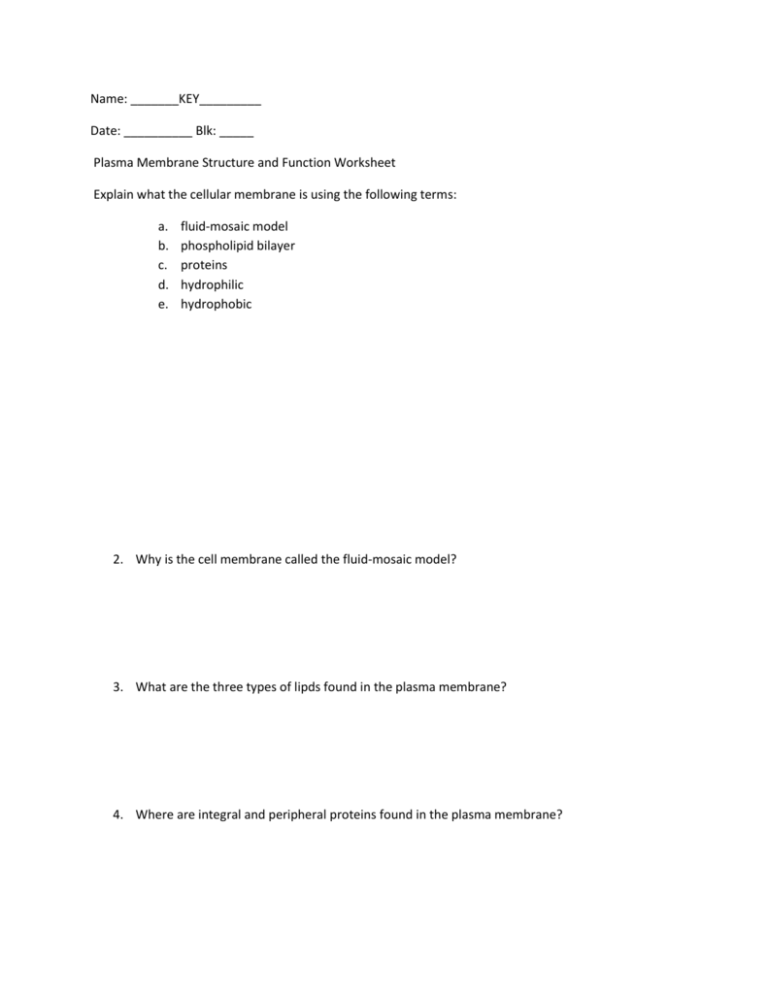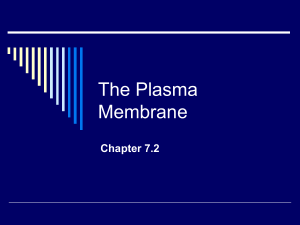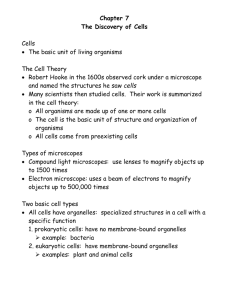4.1 reading for information - Westgate Mennonite Collegiate
advertisement

Name: _______KEY_________ Date: __________ Blk: _____ Plasma Membrane Structure and Function Worksheet Explain what the cellular membrane is using the following terms: a. b. c. d. e. fluid-mosaic model phospholipid bilayer proteins hydrophilic hydrophobic 2. Why is the cell membrane called the fluid-mosaic model? 3. What are the three types of lipds found in the plasma membrane? 4. Where are integral and peripheral proteins found in the plasma membrane? 5. Can the phospholipid molecules move sideways and flip-flop? Why or why not? 6. In general, can the proteins in the plasma membrane migrate? Why or why not? 7. Explain the two types of proteins found in the plasma membrane . 8. Protein form different patterns in particular membranes and also within the same membrane at different times. (True or False? Explain why) 9. Place an "X" next to any of the statements below that are true about the plasma membrane. ______ The greater the concentration of unsaturated fatty acids, the more fluid is the bilayer ______ Phospholipid molecules flip-flop from one layer to the other. ______ Most proteins can drift laterally in the fluid lipid bilyaer. ______ The carbohydrate portions of glycoproteins and glycolipids project internally. 10. Draw and label a phospholipid. Show the hydrophobic and hydrophilic regions. 11. Complete the following table to understand the functions of each component in a plasma membrane. CHEMICAL COMPONENT Lipids: Cholesterol Phospholipid bilayer Proteins: Channel protein Carrier protein Receptor protein Enzymatic protein Cell Recognition protein FUNCTION Name: _______KEY_________ Date: __________ Blk: _____ Plasma Membrane Structure and Function Worksheet 1. According to the fluid-mosaic model for the plasma membrane, there is a phospholipid bilayer in which proteins are scattered throughout the membrane. The hydrophilic (water loving) polar heads of the phospholipids face the intracellular and extracellular fluid. The hydrophobic (water hating) nonpolar tails of the phospholipid molecules face each other. 2. Why is the cell membrane called the fluid-mosaic model? The fluid-mosaic model of membrane structure shows a phospholipids layer in which protein molecules are embedded. 3. Phospholipids have their hydrophilic polar heads facing the intracellular and extracellular fluid. The hydrophobic nonpolar tails face each other. The other two types of lipids present in the plasma membrane are the glycolipids and cholesterol. 4. Where are integral and peripheral proteins found in the plasma membrane? Integral – within membrane Peripheral – on either side of the membrane 5. Can the phospholipid molecules move sideways and flip-flop? Why or why not? Yes and no 6. In general, can the proteins in the plasma membrane migrate? Why or why not? Yes 7. The proteins found in the plasma membrane may be integral proteins, which are found within the membrane, or peripheral proteins, which occur either on the cytoplasmic side or the outer surface side of the membrane. 8. Protein form different patterns in particular membranes and also within the same membrane at different times. (True or False?) True. The peripheral proteins associated with a membrane often have a structural role to stabilize and shape the plasma membrane. 9. Place an "X" next to any of the statements below that are true about the plasma membrane. __X___ The greater the concentration of unsaturated fatty acids, the more fluid is the bilayer ______ Phospholipid molecules flip-flop from one layer to the other. __X___ Most proteins can drift laterally in the fluid lipid bilyaer. ______ The carbohydrate portions of glycoproteins and glycolipids project internally. 10. Draw and label a phospholipid. Show the hydrophobic and hydrophilic regions. 11. Complete the following table to understand the functions of each component in a plasma membrane. CHEMICAL COMPONENT Lipids: Cholesterol Phospholipid bilayer Proteins: Channel protein Carrier protein Receptor protein Enzymatic protein Cell Recognition protein FUNCTION Reduces the permeability of the membrane to most biological molecules Acts as a barrier between the inside and outside of the cell Allows a particular molecule to pass through the membrane Selectively interacts with a specific molecule so that it can cross the membrane Has a particular shape that allows a specific molecule, such as hormone to bind to it Catalyzes a specific reaction Helps immune system recognize cells as “self” or “other” and kills “other” cells









